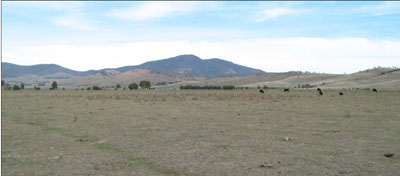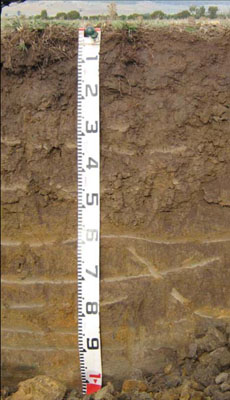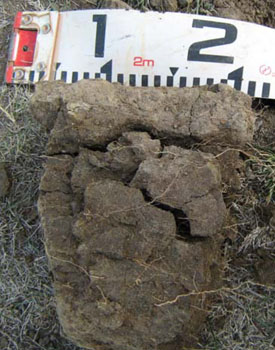EGC204
Location: Benambra (East of township)
Australian Soil Classification: Sodic, Eutrophic, Black CHROMOSOL
Map Unit: Benambra (Component 1)
Previous Site Name: EG204
General Landscape Description: Almost level plain
Land Use: Grazing on annual pasture
Native Vegetation: Montane grassland
Geology: Pleistocene to recent alluvial deposits

Soil Profile Morphology:
| Surface soil |  | ||
| A1 | 0 – 15 cm | Very dark greyish brown (10YR3/2); clay loam; moderate coarse (20 – 50 mm) polyhedral structure; firm consistence dry; abrupt change to: | |
| Subsoil | |||
| B21 | 15 – 45 cm | Very dark grey (10YR3/1); medium clay; strong very coarse (> 50 mm) prismatic structure; very firm to strong consistence dry; | |
| B22 | 45 – 80 cm | Brown (10YR5/3); medium clay; strong very coarse (> 50 mm) prismatic to lenticular structure; strong consistence dry; clear change to: | |
| D | 80 – 105+ cm | Yellowish brown (10YR5/6); sandy clay; apedal; strong consistence dry; becoming sandier with depth. |
Key Profile Features:
- Texture contrast between the surface (A1) horizon and subsoil (B21) horizon.
- Strongly structured subsoils.
Soil Profile Characteristics:
- | pH | Salinity | ||
Surface soil (A1 horizon) | Strongly Acid | Very Low | Non-sodic | None |
Subsoil (B21 horizon) | Slightly Acid | Very Low | Non-sodic | Slight1 |
Deeper subsoil (B22) | Slightly Alkaline | Very Low | Sodic | None |
Chemical and Physical Analysis:
Horizon | Horizon Depth (cm) | pH (water) | EC dS/m | Coarse Sand (0.2-2.0 mm) % | Fine Sand (0.02-0.2 mm) % | Silt (0.002-0.02 mm) % | Clay (<0.002 mm) % | Field Capacity % w/w | Wilting Point % w/w |
A1 | 0-15 | 5.3 | 0.09 | 17 | 35 | 18 | 20 | 31.4 | 11.1 |
B21 | 15-45 | 6.1 | <0.05 | 19 | 28.5 | 18 | 30 | 27.5 | 15.0 |
B22 | 45-80 | 7.7 | 0.13 | 22.5 | 31 | 16 | 26 | 26.0 | 14.4 |
Management Considerations
Whole profile
|  |
Soil Profile Described By: Heather Adams, Julieanne Sargant and Ian Sargeant, June 2009.


